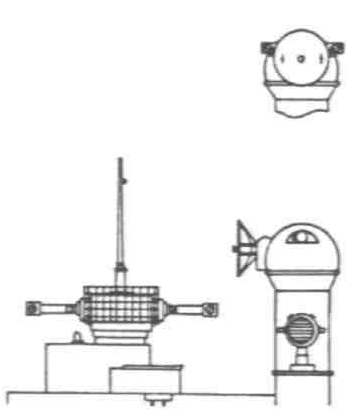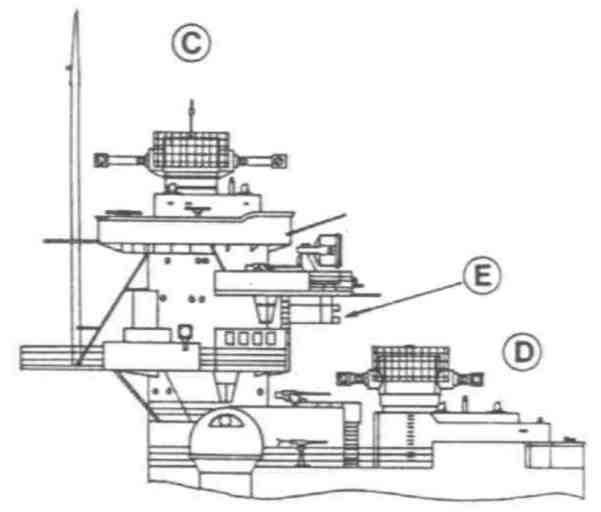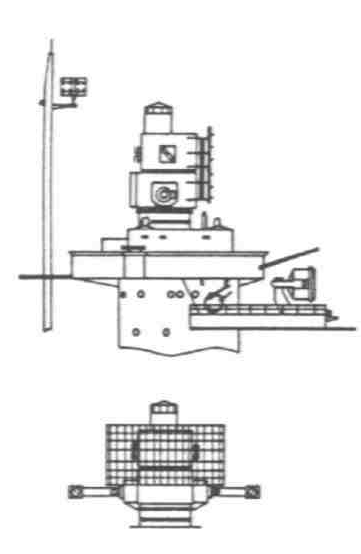| As the added weight of the radar tower
resulted in a critical surplus load on the sensitive bearing engines of
the rangefinder tower, both these battleships were fitted with enlarged
towers, for all three gunnery rangefinders, housing both a FuMO 23 and
the optical equipment. The installation of a fourth mattress antenna on
the front of Bismarck's conning tower is the subject of controversy
in German literature. The dimension of the structure appear to indicate
that it had two rows of dipoles for active or passive detection, but the
clarifying details are obscured in all photographs by a canvas cover.
The Tirpitz was re-equipped while
she was based in Norway as part of the German standby force. Probably in
January 1942 the foretop rangefinder tower was topped with an additional
radar tower, carrying a FuMO 27 mattress antenna and a smaller frame, for
the Timor antennas, above it. The sides and the rear of the radar
tower were fitted with Sumatra antennas. In about the spring or
summer of 1944 Tirpitz received an enlarged 3m x 6m mattress antenna,
probably for FuMO 26. Careful examination of Tirpitz photographs
reveals a small frame of a pole on top of the foretop tower, later moved
to a bracket on the foremast to avoid interference with the FuMO 26. It
is possible that this was either an experimental installation of FuMO 30
or the later standard frame for the Palau dipoles serving a FuMB
6. The addition of a trainable antenna frame to supplement the fixed antennas
seems logical, but this would be the only appearance of a FuMO 30 on a
German surface unit, it having originally been developed to submarines.
Again in the spring or summer of 1944,
the third AA director, fitted just abaft the mainmast (German nickname
'Wackeltopf') was raised by 2m and equipped with an AA gunnery radar,
probably Würzburg-C or Würzburg-D. As previously
mentioned the Würzburg had originally been developed for the
Luftwaffe,
but it was later navalised for the German Navy's AA shore batteries under
the following designation: FMG 39T/C (later FuSE 62C) Würzburg-C
became the Navy FuMO 212, and FMG 39T/D (later FuSE 62D) Würzburg-D
became the Navy FuMO 213. This reveals a fact that has not previously been
published.
Tirpitz had the most sophisticated
radar equipment of all the larger German surface units. However, without
interviewing eye-witnesses we cannot know that these sets were not experimental,
nor how effective they were under battle conditions. In this connection
it would be most interesting to read British intelligence reports on the
ship and to see Torstein Raaby's photographs of her. Torstein Raaby, who
became famous after the war as member of Thor Heyerdahl's Kon Tiki
expedition, was with the Norwegian resistance during the war and for ten
months the spent much of his time on the top of the church tower of the
Village of Alta watching the movements of the German capital ships lying
in Kaa Fjord. He had a radio set, and camera with a telephoto lens, and
his detailed reports to the British helped to ensure the ultimate destruction
of the Tirpitz. As far as I know, his photographs have never been
published, so where are they now?
|

Picture 5.4
The after 10.5m rangefinder
tower with FuMO 23 antennas (Tirpitz only 1940 - 12 Nov 1944).
The third 3-D, stabilized
AA director with the 3m diameter parabolic dish antenna of FuMO 212 or
213. The base ring on the director was raised 2m in the spring/summer of
1944 (Tirpitz only).
|

Picture
5.5
(C) Foretop 10.5m rangefinder
tower and FuMO 23 antenna, 1940 - 12 Jan 1942.
(D) Forward 7m rangefinder
tower and FuMO23 antenna, 1940 - 12 Nov 1944 (Tirpitz).
(E) Possible FuMO
21 dipoles in Bismarck, not definite proof for this assumption.
|

Picture
5.6
Foretop rangefinder
tower crowned by an additional radar office, with FuMO 27 antenna, and
topped by observer's post.
On the short pole
on the roof of the radar hut is the Timor antenna of FuMO 4 Samos,
January 1942 - Spring/Summer 1944. |

Picture
5.7
Foretop tower and radar
hut supporting the large FuMO 26 antenna. FuMO 30 Hohentwiel placed
on the foremast, Spring/Summer 1944 - 12 November 1944. |
|